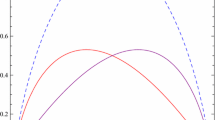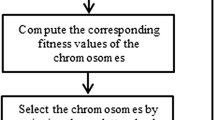Abstract
This paper discusses fuzzy portfolio selection problem in the situation where each security return belongs to a certain class of fuzzy variables but the exact fuzzy variable cannot be given. Two credibility-based minimax mean-variance models are proposed. The crisp equivalents of the models to linear programming ones are given in three special cases. In addition, a general solution algorithm is also provided. To help understand the modeling idea and to illustrate the effectiveness of the proposed algorithm, one example is presented.




Similar content being viewed by others
References
Abdelaziz FB, Aouni B, Fayedh RE (2007) Multi-objective stochastic programming for portfolio selection. Eur J Oper Res 177:1811–1823
Ammar EE (2008) On solutions of fuzzy random multiobjective quadratic programming with applications in portfolio problem. Inf Sci 178:468–484
Arenas-Parra M, Bilbao-Terol A, Rodríguez-Uría MV (2001) A fuzzy goal programming approach to portfolio selection. Eur J Oper Res 133:287–297
Bilbao-Terol A, Pérez-Gladish B, Arenas-Parra M, Rodríguez-Uría MV (2006) Fuzzy compromise programming for portfolio selection. Appl Math Comput 173:251–264
Carlsson C, Fullér R, Majlender P (2002) A possibilistic approach to selecting portfolios with highest utility score. Fuzzy Sets Syst 131:13–21
Castellano G, Fanelli AM, Pelillo M (1997) An iterative pruning algorithm for feedforward neural networks. IEEE Trans Neural Netw 8:519–537
Chow K, Denning KC (1994) On variance and lower partial moment betas: the equivalence of systematic risk measures. J Bus Financ Account 21:231–241
Corazza M, Favaretto D (2007) On the existence of solutions to the quadratic mixed-integer mean-variance portfolio selection problem. Eur J Oper Res 176:1947–1960
Deng XT, Li ZF, Wang SY (2005) A minimax portfolio selection strategy with equilibrium. Eur J Oper Res 166:278–292
Elton EJ, Gruber MJ (1995) Modern portfolio theory and investment analysis. Wiley, New York
Grootveld H, Hallerbach W (1999) Variance vs downside risk: is there really that much difference?. Eur J Oper Res 114:304–319
Hirschberger M, Qi Y, Steuer RE (2007) Randomly generatting portfolio-selection covariance matrices with specified distributional characteristics. Eur J Oper Res 177:1610–1625
Holland J (1975) Adaptation in natural and artificial systems. University of Michigan Press, Ann Arbor
Huang X (2007a) Portfolio selection with fuzzy returns. J Intell Fuzzy Syst 18:383–390
Huang X (2007b) Two new models for portfolio selection with stochastic returns taking fuzzy information. Eur J Oper Res 180:396–405
Huang X (2008a) Portfolio selection with a new definition of risk. Eur J Oper Res 186:351–357
Huang X (2008b) Mean-Semivariance Models for Fuzzy Portfolio Selection. J Comput Appl Math 217:1–8
Huang X (2008c) Expected model for portfolio selection with random fuzzy returns. Int J Gen Syst 37:319–328
Huang X (2009) A review of credibilistic portfolio selection. Fuzzy Optim Decis Making 8:263–281
Lacagnina V, ecorella A (2006) A stochastic soft constraints fuzzy model for a portfolio selection problem. Fuzzy Sets Syst 157:1317–1327
Leshno M, Ya V, Schochen S (1993) Multilayer feedforward networks with a nonpolynominal activation can approximate any functions. Neural Netw 6:861–867
Li J, Xu JP (2009) A novel portfolio selection model in a hybrid uncertain environment. Omega 37:439–449
Li X, Liu B (2007) Maximum entropy principle for fuzzy variable. Int J Uncertain Fuzziness Knowl Based Syst 15(Suppl):43–52
Liu B (2002) Theory and practice of uncertain programming. Physica-Verlag, Heidelberg
Liu B, Liu Y-K (2002) Expected value of fuzzy variable and fuzzy expected value models. IEEE Trans Fuzzy Syst 10:445–450
Liu SC, Wang SY, Qiu WH (2003) A mean-variance-skewness model for portfolio selection with trancaction costs. Int J Syst Sci 34:255–262
Markowitz H (1952) Portfolio selection. J Financ 7:77–91
Markowitz H (1959) Portfolio selection: efficient diversification of investments. Wiley, New York
Roy AD (1952) Safety first and the holding of assets. Econometrics 20:431–449
Tanaka H, Guo P, Türksen B (2000) Portfolio selection based on fuzzy probabilities and possibility distributions. Fuzzy Sets Syst 111:387–397
Williams JO (1997) Maximizing the probability of achieving investment goals. J Portf Manag 46:77–81
Zhang WG, Wang YL, Chen ZP, Nie ZK (2007) Possibilistic mean-variance models and efficient frontiers for portfolio selection problem. Inf Sci 177:2787–2801
Acknowledgments
This work was supported by National Natural Science Foundation of China Grant No.70871011, Program for New Century Excellent Talents in University, and the Fundamental Research Funds for the Central Universities.
Author information
Authors and Affiliations
Corresponding author
Rights and permissions
About this article
Cite this article
Huang, X. Minimax mean-variance models for fuzzy portfolio selection. Soft Comput 15, 251–260 (2011). https://doi.org/10.1007/s00500-010-0654-3
Published:
Issue Date:
DOI: https://doi.org/10.1007/s00500-010-0654-3




